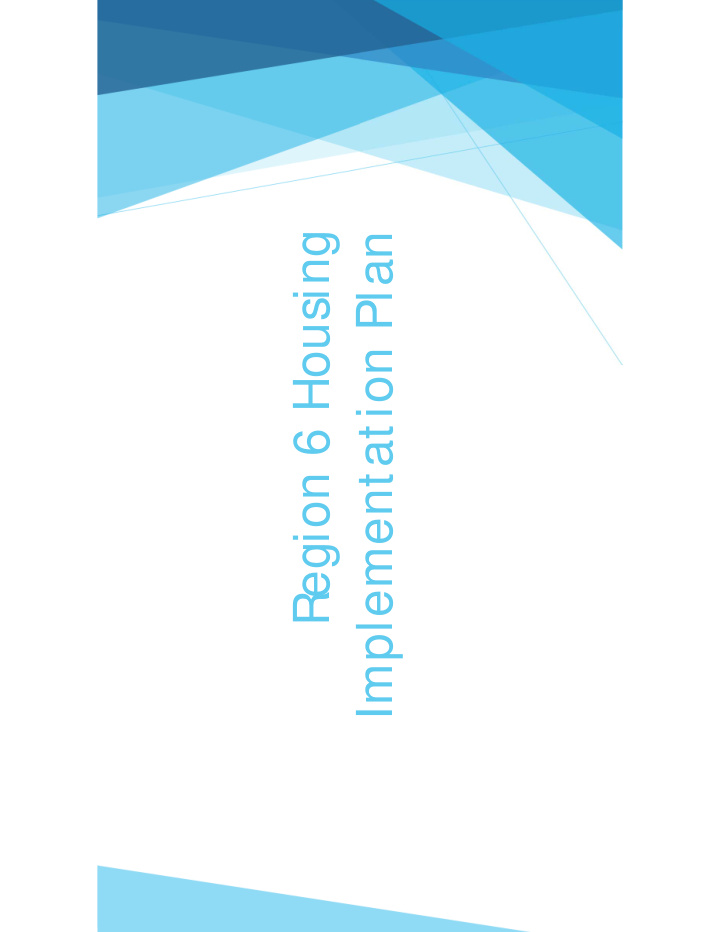



Region 6 Housing Implementation Plan
Current Conditions – What we know Extremely low vacancy rates across the region for both owner-occupied and rental units Median unit value is between $95,000 - $145,000 Very few active listings in the marketplace Average listing price is $156,000 R egion is still getting older, median age is 39 Downtowns are seeing strong pressure for housing
What we’ ve learned (buyer side) Much of the population is at the limit of what they can afford (1/ 3 of monthly income) R esidents still have high levels of debt (credit card, student loans… ) S ome buyers have been able to save for down payments, but the maj ority in the middle market are still struggling Looking specifically at buyers with incomes between $30k and $75k, there is a very large market place for potential buyers 25% of workforce within the region commutes from outside the region opening up a potentially large market of new residents to attract
What we’ ve learned (Builder side) A very tight labor market has constrained the construction industry by adding cost and time for new construction. Many new builds average 7-10 months to complete. R egulatory environment is adding maj or costs to construction –20% - 30% in some cases. Building permits are on the rise, but not at the rate they should be. In 2004, the cost of new construction was between $115 and $130 per square foot In 2018, the cost of new construction is between $170 and $200 per square foot. There is a need for a uniform and consistent development review process across the region.
What’s Working Project Location Developer Housing Type/Costs per Month 1‐2‐bedroom apartments, $200‐ Cavalier Green City of Corunna Woda Group $600 per month 1,200 – 1,700 sf single family Osborne Lakes City of Owosso homes and vacant lots from Public Private Partnership (PPP) with City of Owosso $150,000 1,400 – 2,100 sf single family Lexington Oaks City of Fenton PPP with City of Fenton and Mitchell Builders homes from $220,000 1,200 – 1,600 sf duplex condos Sleepy Hollow Mundy Township starting from $170,000 1,200 – 1,700 sf single family Mallard Ponds City of Burton homes and vacant lots from PPP with City of Burton and VIP Homes $150,000 New homes to qualified buyers at Habitat for Humanity Region wide Habitat for Humanity an accessible price. Collaborative effort between Communities First Inc., RAD Conversion 1‐2‐bedroom apartments for low Specialists, Michigan State Housing Development Authority, U.S. Swayze Court Apartments City of Flint and moderate‐income Department of Housing and Urban Development, City of Flint, households Genesee County Land Bank Authority, Chase Bank, National Equity Fund, and Michigan LISC. 107‐unit, 3 story, brick apartment complex with 1 and 2 bedroom St. Clair Place Apartments City of St. Clair St. Clair Place II, LLC apartments ranging from 650 – 1,000 sf. 150 – 200 new single‐family condos between 1,400 and 1,600 New subdivision City of Marysville Boddy Construction Co. sf starting from $175,000 to $225,000 118 single family homes, 1,600‐ Drakeshire Subdivision Village of Almont 2,200 sf starting around $155,000 Multiple developers 1,750 sf condos with garages Imlay Place Condominiums Imlay City Unknown starting at $115,000 New Apartments City of Lapeer 148 Units Unknown
Implementation proj ects/ strategies/ priorities Municipal Role Look at regulatory costs (tap fees, review fees) Develop an inventory of properties that are development ready (roads, water, sewer… ) Community survey of housing wants and needs Pre-approval/ zoning approvals to anticipate or catalyze development Acquire land for redevelopment purposes Extend infrastructure if possible
Implementation proj ects/ strategies/ priorities Municipal Role continued Obtain ownership of tax foreclosed properties Review ordinances to ensure target housing types and densities are permitted by right Identify land and determine housing types most appropriate S ubdivide into multiple lots Individual developable lots Multi-family Mixed-use and urban housing types such as townhouses, flats… Consider accessory dwelling units to diversify housing options and increase densities where desired Recruit local companies and banks to create development partnerships
Implementation proj ects/ strategies/ priorities R egional R ole Complete a regional “ development review process” fee survey and best practices guide to share regionally Promote opportunity zones as a development finance tool Complete a regional branding strategy focused towards housing developers Complete a regional inventory of development ready sites with infrastructure to promote on the regional website Develop a housing finance partnership/ consortium for the region to assist with development proj ects Lobby MEDC to include housing development as part of their Collateral S upport/ Loan Participation Programs
Implementation proj ects/ strategies/ priorities Regional Role Continued Target commuter workforce for new housing opportunities within the region Promote construction j obs and increased trades training to increase development opportunities (ensure workforce availability) Work with local employers to financially support development proj ects to attract workers, or to have a housing allowance for existing workers to live within the region or as a worker attraction tool Work with state legislators to bring development review/ approval time in the subdivision control act in line with the condominium act Prepare online and print content to promote development opportunities across the region Partner with the state and local Home Builders Associations to promote new opportunities Build a coalition of builders and realtors to identify and promote new opportunities
Performance measures What is “ progress” ? When is the j ob “ done” ? Where will the funding come from? Who is responsible?
Questions?
Recommend
More recommend